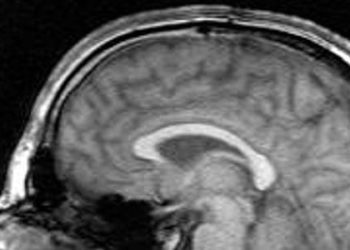New molecular probes for melanoma imaging and treatment [PreClinical]
1. α-melanocyote stimulating hormone (α -MSH) and its analogs can bind tightly to the melanocortin-1 receptor (MC1R), a G protein-coupled receptor that is overexpressed in melanoma cells.
2. Radionuclide and fluorescent MSH probes demonstrate MC1R-specific targeting properties in murine and human melanoma cells and tumors.
Evidence Rating Level: 2 [Good]
Study Rundown: Malignant melanoma is an aggressive cancer that accounts for 75% of all skin cancer deaths. While new molecular therapies including targeting the BRAF-V600E mutation and immunotherapies including CTLA-4 and PD-1 targeting approaches have showed promise in extending patient survival by months, long-term survival remains at <10%. An alternative potential approach to treating metastatic melanoma relies on the observation that melanocortin-1 receptor (MC1R), a G protein-coupled receptor, is overexpressed in melanoma cells. α-melanocyote stimulating hormone (α-MSH) and its analogs can bind to MC1Rs with high binding affinities. In this study, radiolabeled α-MSH peptides were evaluated for their potential as imaging probes and as agents for the targeted radionuclide therapy of melanoma.
Several radiolabeled lactam-cyclized α-MSH peptides were iteratively synthesized and developed over the course of several years. These peptides were built on a construct that was readily radiolabeled with 111In and 67Ga for melanoma imaging using single photon emission computed tomography (SPECT) and 177Lu for potential targeted radionuclide therapy. These probes were tested in murine models of melanoma for certain characteristics. For imaging, a probe was chosen that had high melanoma tumor uptake, fast urinary clearance, and high tumor/normal organ uptake ratios at 2 hours after injection. For potential radionuclide therapy, a probe was chosen that had characteristics of high melanoma tumor uptake and prolonged melanoma retention 24 hours after injection. After developing MC1R-targeted peptides with these features, the authors extended their studies to construct positron emission tomography (PET) probes, which offer high sensitivity and fast acquisition characteristics that could enable targeted radionuclide therapy in MC1R-positive melanoma patients. In addition to this novel PET imaging probe, the authors developed a MC1R-targeting fluorescent imaging probe that could potentially provide opportunities for image-guided surgical removal of melanoma lesions.
The receptor binding affinities of the MC1R-targeting PET and fluorescent imaging probes were determined on murine and human melanoma cell models. The specificity and biodistribution of the PET probe were examined in melanoma mouse models and human melanoma xenograft models. Furthermore, the PET probe was evaluated, for the first time, in two patients with metastatic melanoma. The novel PET probe demonstrated moderate to strong uptake in metastastic melanoma lesions, as confirmed by 18F-FDG PET/CT. These results suggest the promise of this new probe as an agent for the specific identification and targeted treatment of MC1R-positive metastatic melanoma.
Click here to read the study in Science Translational Medicine
Relevant Reading: Radionuclide therapy of melanoma
In-Depth [pre-clinical study]: The objective of this study was to develop novel MC1R-targeting therapeutic agents for imaging and treating patients with metastatic melanoma. Two probes were tested in this study: a PET probe 68Ga- DOTA-GGNle-CycMSHhex and a fluorescent probe Cy5.5-GGNle-CycMSHhex.
The specificity of labeling with the PET probe was evaluated. This probe showed ~80-90% labeling on B16/F10 and M21 melanoma cells. The uptake of the fluorescent probe was substantially inhibited by peptide blockade of MC1R, supporting specific binding of the probe to MC1R. The biodistribution of both probes were determined in melanoma-bearing mice. Tumor uptake of the PET probe was ~25% ID/g 1 hour post-injection, with prolonged tumor retention (~12% ID/g) 2 hours post-injection. Co-injection of nonradioactive α-MSH hormone blocked 92% of tumor uptake 1 hour after injection, demonstrating that uptake of the PET probe was MC1R-mediated. Whole-body clearance of the probe was rapid, with 92% of the injected dose cleared by 2 hours post-injection. The kidneys exhibited the highest (non-MC1R-specific) uptake of the probe of all normal organs
Both flank B16/F10 tumors and M21-xenografted tumors could be visualized by PET using the PET probe at 0.5, 1, and 2 hours after injection with best imaging contrast achieved at 1 hour post-injection. The first in-human imaging of two patients with metastatic melanoma showed moderate to strong uptake in melanoma lesions, consistent with 18F-FDG PET/CT imaging. However, compared to the more homogenous uptake of 18F-FDG in metastases, the uptake of the novel PET probe was more heterogeneous, suggesting that metastatic tumors may have different MC1R expressions.
Image: PD
©2018 2 Minute Medicine, Inc. All rights reserved. No works may be reproduced without expressed written consent from 2 Minute Medicine, Inc. Inquire about licensing here. No article should be construed as medical advice and is not intended as such by the authors or by 2 Minute Medicine, Inc.







